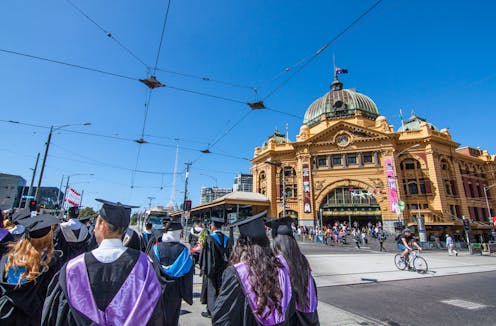
Over the weekend, the Albanese government announced radical changes to student loans, which would kick in after the next federal election.
Three million Australians with student debt could see their balances cut by 20%. The remaining debt would be repaid under a new system, with no compulsory repayments for people earning less than A$67,000 a year. Both changes require parliamentary approval.
The changes will apply to everyone with a student debt, including all HELP (formerly HECS), vocational education and Australian apprenticeship support loans, as well as other student support loans.
People with student debt would undoubtedly benefit from the proposed changes. But they come with a hefty price tag and some disadvantages.
What are the proposed cuts to student debt?
As of June 30 this year, Australia’s higher education student debt totalled about $75.1 billion – although this is soon set to drop by about $3 billion. Legislation to partially reverse recent indexation to debts will go to the Senate later this month.
However, staying with the $75 billion, a 20% cut would be about $15 billion.
Using the government’s figures, someone with the average HELP debt of $27,600 would see around $5,520 cut from their HELP loans next year.
Vocational education students owed $8.4 billion as of June 30 2024. Their balances would reduce by about $1.7 billion under the changes.
Based on previous student support loan data, this debt is more than $3 billion. The changes would see it drop by about $600 million.
These reductions total $17.3 billion compared to the government’s estimate of $16 billion. But the upcoming indexation changes may explain this difference.
Repayments set to change
These changes have two important elements: the income at which repayments start and how repayments are calculated.
These changes come amid a cost-of-living crisis and rising fees for students.
There was a noted outcry earlier this year when the cost of an arts degree hit $50,000 for 2025.
No compulsory repayments if you earn under $67,000
With parliament’s approval, for 2025-26 compulsory repayments on student loans would not start until the debtor was earning $67,000. This is up from about $56,000.
This would help a significant number of Australians. In 2023-24 more than 400,000 debtors had incomes between $50,000 and $70,000.
Changes to how repayments are calculated
Another significant change is to how repayments are calculated. Currently, when a debtor’s income reaches one of 18 income levels they repay a higher percentage, based on all their income.
This can produce strange results. Take a graduate earning $62,850 a year. They are in the 1% of income repayment rate, so they owe the Australian Taxation Office $628.50 in HELP repayments. But if their income goes up by $1 to $62,851 they enter the 2% repayment bracket, and owe the tax office $1,257. So a $1 pay increase would reduce the graduate’s take home pay by more than $600.
Under the government’s proposal, repayments would be calculated on income above a threshold, ignoring all income below the first threshold.
The new system would start with a 15% repayment rate at incomes between $67,000 and $124,999. Income at $125,000 or above would have a 17% repayment rate.
So, take a graduate on $70,000 a year. Under the current system, they will repay 2.5% of all their income, which is $1,750. Under the proposed system their repayments will be calculated only on the $3,000 difference between $67,000 and $70,000. This means they pay 15% of $3,000 or $450.
The government says on average, repayments will drop by $680 per individual debtor.
But those earning $180,000 plus will repay more student debt each year due to the new system. This is not a large group. Of the 1.16 million people who made a HELP repayment in 2021-22, all but 16,000 earned less than $180,000.

There are some disadvantages
The downside of reduced annual repayments is longer repayment periods and more indexation of HELP balances.
People who want to repay more quickly can make voluntary repayments, which have increased significantly in recent years. But most people take the default option of compulsory repayments only.
While people who currently hold debt will see their repayment times reduced after the 20% cut to their balance, future borrowers won’t have this benefit.
Given the pattern of recent announcements, it would not be surprising if the government also announced reduced student contributions for future borrowers.
But it is also surprising the government has been stalling for two years on the high cost of arts degrees, set to hit almost $17,000 a year next year. These high fees should have been reduced long ago.
The cost to government
The 20% reduction in student debt balances will also come at a very significant cost to government and taxpayers.
This will not be the full $16 billion they have announced, since that includes debt that is not expected to be repaid anyway.
For higher education debt, the government actuary estimates 24% of the debt outstanding as of June 30 this year will not be repaid. Even so, a 20% cut to the $57.1 billion “good” debt would still cost $11.4 billion.
Cutting vocational education debt by 20% would add around another $1 billion to the cost, after deducting debt that won’t be repaid. Debts for student income support tend to have high bad debt rates, but the 20% cut for them would also add to the government’s expenditure.
The government will also incur further costs from slowing down future repayments.
Is this the best way?
The last few years have highlighted how stressful and damaging high levels of student debt can be for younger Australians.
And as Labor looks ahead to the next federal poll, reducing individuals’ debts and repayments could be a useful election selling point.
However, the Albanese govenrment’s plan comes with a high price tag and the priorities may not be entirely right. Managing future debt, such as by reversing fee hikes under the Job-ready Graduates program, is as important as reducing old debt.
Andrew Norton does not work for, consult, own shares in or receive funding from any company or organisation that would benefit from this article, and has disclosed no relevant affiliations beyond their academic appointment.
This article was originally published on The Conversation. Read the original article.







